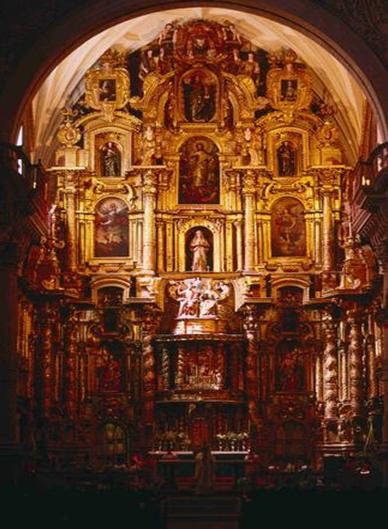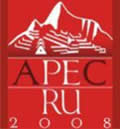United Kingdom
| Welcome |
| Peru in Brief |
| History |
| Geography |
| Government & Politics |
| Maritime delimitation between Peru and Chile |
| News |
Links |
| CUZCO | |||
 |
|||
| La Compañía | |||
| Places of Interest: | CHURCHES: |
||
The Cathedral. Originally erected on the site of the Suntur Wasi (and later renamed Iglesia del Triunfo ), the Cathedral was rebuilt on the Kiswar Cancha , the ground that had been the palace of Viracocha . Works got under way in 1556 under Juan Manuel de Veramendi and continued until August 1669, when the Cathedral was consecrated and opened for service by the bishop Bernardo Izaguirre . |
|||
The Latin-cross plan features three naves, ten side chapels, ambulatories and aisles for Easter week processions plus a chapter house and sacristy. The churches of Triunfo and Jesus Maria y Jose are directly accessible. |
|||
The Cathedral's maximum height is 32.97 m Both the front and the interior are in Renaissance style. The interior is decorated with cedar and alderwood sculptures. |
|||
The most significant paintings are the canvas known as Nuestra Senora la Antigua (also called del Perdon ), the Last Supper by Marcos Zapata , and a Christ on the Cross by a group of mestizo artists who copied a work by the Spaniard Alonso El Cano. Paintings by Diego Quispe Tito , Juan Espinoza de los Monteros, Antonio Sinchi Roca , Basilio, Santa Cruz Pumacallo and several anonymous artists are also displayed. Embossed silver items include the procession carriage and litter, head decorations and other ornaments. Especially worth viewing are the side chapels dedicated to the Lord of Tremors, Our Lady of Relief, the Virgin of Choconchaca, and the Immaculate Conception (La Linda). |
|||
La Compania. Construction of the Jesuits' church began in 1576 on the site of Huayna Capac 's former residence ( Amaru Cancha ); plans were by Francisco Becerra. |
|||
Church and Convent of La Merced. Both were founded by Fray Sebastian de Trujillo y Castaneda at the place called Llimpipata in 1536 (and sanctioned by a bull from Pope Pius IV in 1561. |
|||
The original church and cloisters were used until 1650, when a quake rendered them unserviceable. Construction was completed in 1675, and benefited greatly from the work of indigenous masters such as Alonso Casay and Francisco Monya . Decisive financial support had come from the Pizarro and Almagro families, among others. |
|||
The most noteworthy piece here is the monstrance (currently preserved in the convent's first cloister), its baroque-style upper portion executed by the Spanish goldsmith Juan de Olmos in 1720, the lower half evidencing an earlier Renaissance style but in fact completed in 1 S05 bv the local artist Manuel de la Piedra . Weighing 22.2 kg and measuring 1.30 mt in height, the receptacle is inlaid with 1.518 diamond and 615 pearls in addition to rubies, topazes and emeralds. |
|||
Santo Domingo. Having arrived in Cuzco in 1534, the Dominican order built its first convent (and adjoining church) in Peru on the site of what had been the Incas' most important religious compound, the Coricancha or Temple of the Sun. After the original church collapsed in 1537, reconstruction was undertaken by the architects Juan de Albanil and Marin Gonzales de Lagos. Serious damage was inflicted by the tremor of 1650, as again in 1950, but the church was promptly restored each time. |
|||
San Blas. Cuzco 's oldest parish church was built bv a group of migrants and sailors from Croa'ia and a merchant from Dubrovnik . Basil Basilievic , who had arrived in Peru in 1537. The church contains the most extraordinary piece of artistic carpentry existing in Peru – an all-cedar pulpit in Spanish churrigueresque style whose author is unknown, but which was surely fashioned by indigenous hands. The main altarpiece is in classic, gilded baroque style. Another fine altarpiece is that Grafted by Mateo Tuyro Tupac and dedicated to Our Lady of Good Furtune. |
|||
Church and Convent of San Francisco. Founded by the Franciscan fathers in 1645 and completed in 1652, this two-front, single-belltower compound reflects an older style of Spanish architecture. The convent hosts a monumental (12 x 9 m) canvas by Juan Espinoza de los Monteros depicting the genealogy of the Franciscan family. Paintings by Diego Quispe Tito , Basilio Santa Cruz, Antonio Sinchi Roca and Marcos Zapata , among others, may also be viewed. |
|||
Church and Monastery of Santa Catalina. Both were founded in 1605 by Dona Lucia de Padilla and Don Jeronimo de Pacheco on the site of the old House of the Maidens of the Sun ( Ajlla Wasi ). The architecture is late-Renaissance with Roman-style arcades. The chapterhouse contains mural paintings and other works of art, as well as fine gold and silver items, textiles, sculptures and baroque-style gilded altarpieces. Paintings include works by Juan Espinoza de los Monteros. a huge canvas depicting Our Lady of the Assumption, and a "Glorificacion de Santa Catalina " by Lorenzo Sanchez. |
|||
San Pedro. This parish church was built under the supervision of Juan Tomas Tuyro Tupac in 1668 on the same site as the Hospital de Naturales. Its elegant yet sober interior houses numerous paintings, sculptures, ornamental woodwork and gilded pieces. The pulpit was built and carved by Juan Tomas Tuyro Tupac himself. |
|||
Church and Monastery of Santa Clara. Founded in 1555, the complex rises by the avenue named after Santa Clara . Its design bears the imprint of several Indian and mestizo masters as well as of Fray Manuel Pablo, who completed the structure. |
|||
COLONIAL HOUSES: |
|||
| Archbishop's Palace. Erected over the ruins of Inca Roca's residence on Calle Hatunrumiyoc, the building was occupied by a long sequence of prominent families and individuals – among others, the bishop Vicente de Valverde and the Marqueses de Rocafuerte. Today this Arab-style colonial edifice accomodates Cuzco 's museum of religious art. |
|||
Palacio del Almirante. This is now the archaeological museum. An impressive variety of items found in or around Cuzco , including pottery, textiles, jewellery and mummies from the Inca period are preserved here. |
|||
Casa de los Cuatro Bustos. Located at No. 400, Calle San Agustin , this fine colonial mansion is embellished by rose windows and bas-relief columns; the lintel over the entrance is a single block of carved stone displaying four busts and the coat of arms identifying the Spanish marquises Salas Valdez |
|||
| <BACK> | |||





